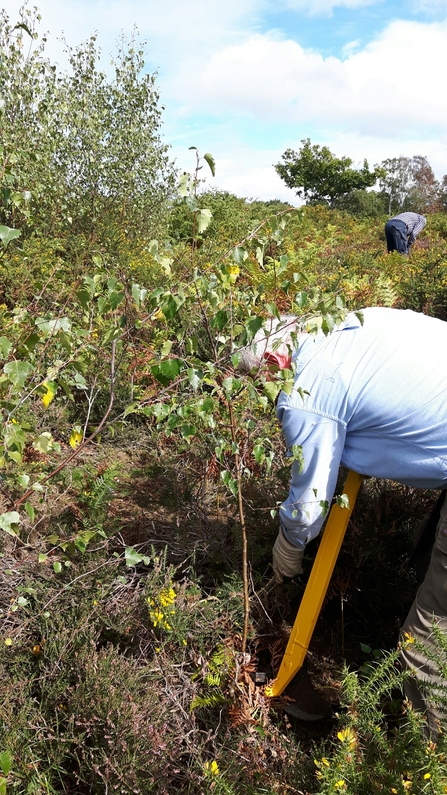Pound Green Common, owned by Worcestershire Wildlife Trust, is the only remaining medieval Common in the Wyre Forest. Funding from Severn Trent Water’s Boost for Biodiversity grant fund is enabling the conservation charity to undertake work to restore heathland and acid grassland plants. Severn Trent announced in March 2020 its largest ever commitment to improve and enhance 5000 hectares of biodiversity across the region.
Heathland restoration to get underway
Encroaching trees and bracken at Pound Green Common

Common lizard amongst heather by Amy Lewis
The work, due to start in February, will see contractors restore parts of the Common to a more open landscape. Some groups of trees, gorse and bracken will be removed in order to allow sunlight to reach the floor, enabling heather and other acid-loving plants to thrive. In other areas, trees will be thinned rather than removed in order to restore wood pasture habitats, where scattered trees are interspersed with diverse grassland.
Andy Harris, the Trust’s officer responsible for the management of Pound Green Common, explained “Pound Green Common is a wonderful place for wildlife and is known to many locals as the place where 1920s naturalist Edgar Chance undertook pioneering research into the lives of cuckoos.
“If you look at that footage from the 1920s, you can see just how much this precious place has changed. Heathlands have been managed by humans for centuries and the wildlife has evolved to thrive under this management. Sadly, many heathlands have been lost through poor management and the wildlife has gone too.
“Thanks to this funding, we’re able to undertake a large chunk of restoration this winter. We know that removing trees isn’t always popular but this is essential if we’re to secure the future of one of Worcestershire’s rarest habitats, heathlands.”
Work to remove trees from a wet flush will return the area back to a haven for reptiles and insects. Removal of trees from around a pool will allow light back into the pool, enabling to thrive with aquatic life once more.

Volunteers 'tree popping' - removing saplings individually by Andy Harris
Where possible the Trust intends to retain older trees and those with character but the spread of ash dieback across the county does mean that a portion of ash trees, including a few larger trees, is necessary, especially where they are situated near paths.
Andy continued “We have a team of volunteers who undertake routine maintenance but they’ve unfortunately not been able to get through as much work over the last 12 months because of the Covid-19 situation. This work will be a real boost to their work and to the ongoing restoration of this special place.”
Pound Green Common is part of the extensive Wyre Forest Site of Special Scientific Interest and is a mosaic of heathland, wet flushes and acid grassland with patches of gorse, bracken and scrub.
The Common has been under-grazed in the past, which has led to a decline in heathland plants and an increase in the number of young trees, bracken and scrub. Grazing animals remove coarser grasses and young saplings, which help to keep the landscape open in nature.
In the 1920s, Edgar Chance organised several filming sessions in order to show how cuckoos were able to lay their eggs in the nests of other birds (in the case of Pound Green Common this was in the nests of meadow pipits). Both meadow pipits and cuckoo numbers have declined significantly and, whilst the reasons for this decline are more complex than a reduction of suitable habitat at Pound Green Common, it is hoped that its restoration will see the return of both species of bird.
The Home Wrecker (https://youtu.be/HxFO6OaDgeQ)
The Home Wrecker featuring Edgar Chance's work by Oliver Pike/Edward Hawkins

Many thanks to Severn Trent Water’s Boost for Biodiversity grant fund, which is enabling this conservation work to take place.
